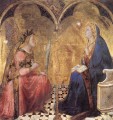Artists
Ambrogio Lorenzetti
- Country:
- Italy
- Birth year:
- 1285
- Death year:
- 1348
Ambrogio Lorenzetti (c. 1285 Siena-1348? Siena) was one of the most important masters of the Sienese gothic. Presumably he studied with his brother Pietro, and afterward worked in his native city until around 1324. In 1327 he became a member of the guild of doctors and apothecaries in Florence, but by 1332 at the earliest he was again working in Siena. Lorenzetti's work unites the traditions of Siena with elements of Florentine art. He found his way to a spiritual deepening of the traditional themes and stylistic methods of Gioto and Simone Martini. His early work is characterized by solid, clear forms and a pure, strong coloration. With objects placed outside the pictorial space. His late works show a comprehensible concept of space that approaches a consciously perspectival representation. In addition, the figures are only slightly reduced to types. Lorenzetti also painted frescoes, seen in the Sala dei Nove, the Loggia, and the Sala del Mappamundo in the Plazzo Pubblico in Siena. His major works include Nursing Madonna, c. 1320-1330, Pontificio Seminario Regionale, Siena; The Annunciation, 1344, Pinacoteca Nazionale, Siena; and Madonna Rapalono, Pinacoteca Nazionale, Siena.





